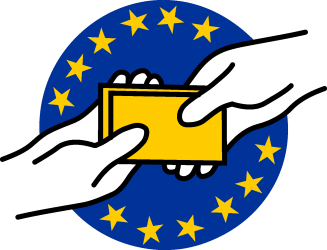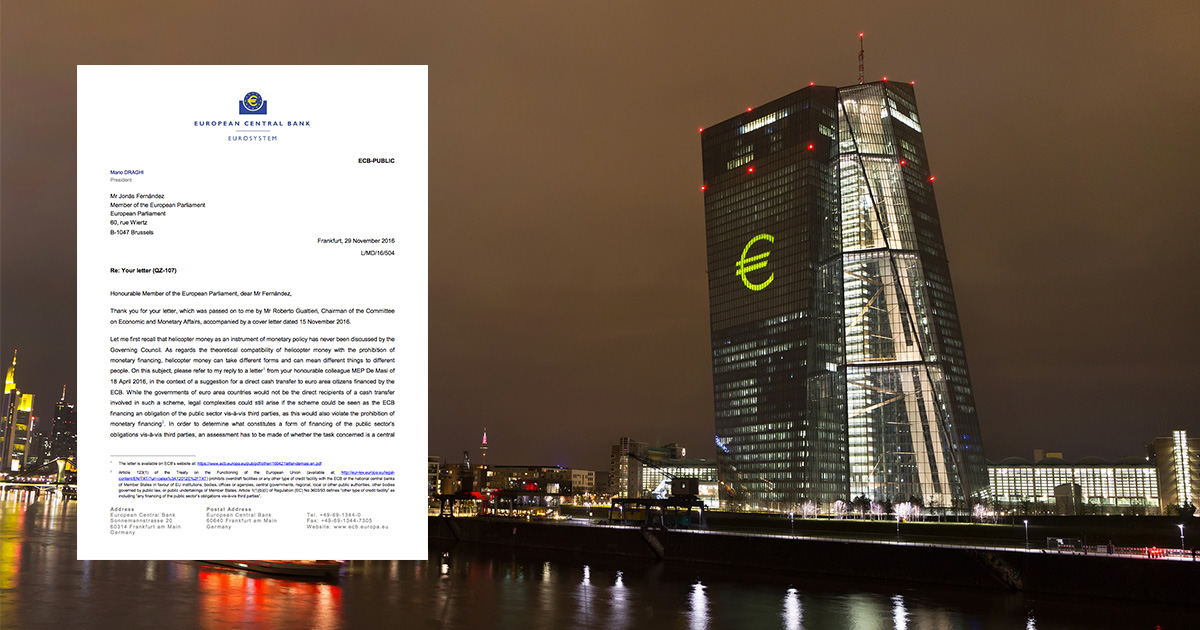Mario Draghi first discussed the notion of ‘helicopter money’ in March 2016, saying “it is an interesting concept.” Since then however, the head of the European Central Bank repeatedly stated that the idea that central banks could distribute money directly to citizens, was fraught with accounting-wise, technical and legal complexity.” However the ECB had declined at several occasion to specify in detail which were the foreseen legal obstacles.
In a letter dated 29 November to Spanish MEP Jonas Fernandez, the ECB finally provides clarifications. And our interpretation of the letter lead to the conclusion that those legal issues are very weak and solvable.
The QE for People campaign praises the ECB for finally providing this legal clarification. “By providing a detailed answer on this point, the ECB acknowledges its understanding of our proposal, which many economists say could bring significant benefits to the economy” said Stan Jourdan, QE for People campaign coordinator.
Helicopter money must be designed as monetary policy
The ECB letter reads: “While the governments of euro area countries would not be the direct recipients of a cash transfer involved in such a scheme, legal complexities could still arise if the scheme could be seen as the ECB financing an obligation of the public sector vis-à-vis third parties, as this would also violate the prohibition of monetary financing.”
For the ECB, the “helicopter money” scheme should be clearly designed as a central bank task in order to comply with EU regulation 3603/93. This regulation considers that the “financing of the public sector’s obligations vis-à- vis third parties” constitutes monetary financing and, therefore, is prohibited. This refers to a very hypothetical situation where, for example, the ECB would substitute for a public institution by fulfilling one of its financial obligations such as social benefits payments. Such scheme is clearly outside of the scope of the proposals we have been arguing for.
“The ECB is right to point out that helicopter money must be framed as a monetary policy tool if it is to be legally implemented in the Eurozone. We have been persistently clear on this point in our proposal, and it’s great that the ECB shows alignment with us,” Fund Manager Eric Lonergan said.
Further on in the letter, the ECB says “an assessment has to be made of whether the task concerned is a central bank or government task.”
Commenting on this, Stan Jourdan said: “This clearly is the core question, but in fact the letter shows that the ECB already knows the answer: if a helicopter money programme is independently designed, decided and implemented by the ECB for the purpose of price stability, then clearly it is a monetary policy task.”
The question of whether ‘helicopter money’ is a monetary or fiscal policy has been subject to a very heated debate among economists over the past year. In our view, helicopter money can have similar economic effects as fiscal stimulus programmes. However in practice such a policy would induce an institutional innovation where central banks effectively use new transmission channels. Such innovation is necessary if central banks want to overcome the ineffectiveness of their main conventional transmission channel (the banking system).
This point is crucially important (and often misunderstood) under the Eurozone legal framework where there is a strict prohibition of central banks using monetary financing of governments’ debt.
How to make ‘helicopter money’ legal in the Eurozone
As we detailed in our recent proposal for a “citizens’ monetary dividend“, helicopter money would be legal in the Eurozone, assuming that it would be designed and implemented in compliance with the following criteria:
- It is designed and supervised independently under the ECB’s own initiative
- The single purpose of CMD is to ensure that the ECB meets its inflation target (although the policy entails other positive side-effects)
- It does not involve national governments or EU institutions’ fiscal policies
- It has no adverse long-term consequences on the ability of the ECB to manage monetary policy
“The ECB should take leadership before populists do”
Eric Lonergan said: “The ECB clearly has the knowledge, resources and capacity to design a citizens’ programme in a way that is compliant with its mandate. The ECB should take leadership in this exercise before populists do it.”
This Thursday the ECB’s governing council is meeting in Frankfurt and is set to decide on extending its quantitative easing programme beyond March 2017.
Now that the ECB has, in effect, confirmed that other options than QE and negative interest rates are possible in some circumstances, the Governing Council should refrain from extending QE next week. Instead, the ECB should dedicate enough time and resources until March to examine all possible options that would contribute more effectively to its price stability mandate.
First Posted by QE for People on December 07, 2016
http://www.qe4people.eu/ecb_letter_helicopter_money_legally_feasible


